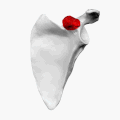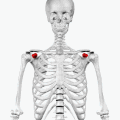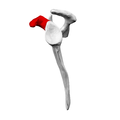Coracoid process
| Coracoid process | |
|---|---|
 Left scapula. Anterior view. Coracoid process shown in red. | |
 Anterior view. Coracoid process shown in red. | |
| Details | |
| Identifiers | |
| Latin | processus coracoideus |
| MeSH | D000070597 |
| TA98 | A02.4.01.023 |
| TA2 | 1159 |
| FMA | 13455 |
| Anatomical terms of bone | |
The coracoid
Structure

The coracoid process is a thick curved process attached by a broad base to the upper part of the
The component parts of the process are the base; angle; shaft; and apex of the coracoid process, respectively. The coracoglenoid notch is an indentation localized between the coracoid process and the glenoid. As the coracoid process projects laterally, it defines the subcoracoid space beneath. [2]
The ascending portion, flattened from the frontal aspect backward, presents in front a smooth concave surface, across which the
The horizontal portion appears flattened when viewed from above looking downward; its upper surface is convex and irregular, and gives attachment to the
On the medial part of the root of the coracoid process is a rough impression for the attachment of the conoid ligament; and running from it obliquely forward and laterally, on to the upper surface of the horizontal portion, is an elevated ridge for the attachment of the trapezoid ligament.[3]
The coracoid process is a snare molded bone design projecting anterolaterally from the unrivaled(?) part of the scapular neck. Surgeons refer to this part of the body as the “lighthouse of the shoulder”[4] as it is close to the area where structures of veins and nerves (neurovascular) are bound together. The distances between the coracoid base and the neurovascular structures is like a 90 degree chair. The suprascapular ligament is right next to the coracoid process. The muscles that are attached are: Pectoralis Minor, Coracobrachialis, and Biceps Brachii.
In addition, this structure attaches all the tendons and ligaments together. There are two purposes for this structure: it is the primary hold by which the clavicle is joined to the scapula and alongside the acromion and coraco-acromial tendon, it shapes the curve over the glenoid. By having the coracoid process, this allows the scapula to not be attached to the skeletons by the bone so that it can only support the limbs. Although there are minor instances where the coracoid process can be damaged by itself, there can still be damage to the structure with an acute subscapularis tear. Usually a disruption in the coracoid process can indicate a shoulder injury such as dislocation and instability.
Attachments
It is the site of attachment for several structures:
Muscles
- The rib.
- The short head of biceps brachii muscle (origin) – to radial tuberosity.
- The coracobrachialis muscle (origin) – to medial humerus.
Ligaments
- The coracoclavicular ligament – to the clavicle. (The ligament is formed by the conoid ligament and trapezoid ligament.)
- The coracoacromial ligament – to the acromion
- The coracohumeral ligament – to the humerus
- The superior transverse scapular ligament – from the base of the coracoid to the medial portion of the suprascapular notch
Clinical significance
The coracoid process is palpable just below the lateral end of the clavicle (collar bone). It is otherwise known as the "Surgeon's Lighthouse" because it serves as a landmark to avoid neurovascular damage.[5] Major neurovascular structures enter the upper limb medial to the coracoid process, so that surgical approaches to the shoulder region should always take place laterally to the coracoid process.
Other animals
In monotremes, the coracoid is a separate bone. Reptiles, birds, and frogs (but not salamanders) also possess a bone by this name, but is not homologous with the coracoid process of mammals.[6]
Analyses of the size and shape of the coracoid process in
Anthropologists examine the coracoid process when studying shoulder morphology to determine whether the upper limbs provided support for bipedalism in the early hominin ages.
According to the authors of “The human acromion viewed from an evolutionary perspective”, there were different shapes of surface of the coracoid process within the various hominins.[11] The gorillas had a wide shape, chimpanzees, orangutans and humans had an intermediate shape, and the gibbon had a small shape. This can further be analyzed as the different hominids have variability in their shape of the coracoid process. The latest contributions to the evolutionary coracoid process were from Doctor M. Hussan in 2016 where he added further insight on the significance of the subacromial impingement and coracoacromial arch’s importance with the aid of pathology.
Additional images
-
Left scapula. Coracoid process shown in red.
-
Animation. Coracoid process shown in red.
-
Left scapula. Lateral view. Coracoid process shown in red.
References
- ^ Liddell, Scott, Jones Ancient Greek Lexicon (LSJ)
- S2CID 237348158.
- ^ Gray's Anatomy (1918), see infobox.
- PMID 27471875.
- PMID 9658354.
"...defined by Matsen et al. as 'the lighthouse of the shoulder.'
- Matsen, Frederick A; Lippitt, Steven B; Sidles, John A; Douglas T, Harryman (1984). Practical Evaluation and Management of the Shoulder. Saunders. ISBN 978-0-7216-4819-4.
- Matsen, Frederick A; Lippitt, Steven B; Sidles, John A; Douglas T, Harryman (1984). Practical Evaluation and Management of the Shoulder. Saunders.
- ISBN 0-03-910284-X.
- ISBN 978-1-4020-9979-3.
- ISBN 978-94-007-5918-3, retrieved 2022-03-04
- PMID 17104786.
- .
- PMID 25454328.
External links
- Anatomy image: skel/scapula2 at Human Anatomy Lecture (Biology 129), Pennsylvania State University
- Coracoid Process - BlueLink Anatomy, University of Michigan Medical School



